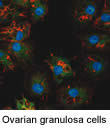
Alan Johnson’s research is driven by a fundamental question: “Why this one and not that one?” The “this” and “that” are follicles, the structures that surround the eggs in the ovary. Specifically, the Notre Dame professor of biology is interested in learning why, at the time of ovulation, one particular follicle releases its egg while others don’t.
It turns out a layer of cells within the follicle, known as granulosa cells, is crucial to the process, and Johnson has spent most of his career studying the intricacies of these abstruse cells. Recently, he and research associate Dori Woods moved a step closer to unraveling the granulosa mystery. In their analyses of chicken granulosa cells, Woods found that some type of inhibitory chemical signal appears to hold nonovulating follicles in check. Through an as yet uncharacterized chemical process, an ovulating follicle is released from this inhibitory signal.
Johnson’s current research is focused on learning the details of this process. The work has implications for understanding a rare form of ovarian cancer as well as fertility. “It happens that these granulosa cell tumors come from the stage that is suppressed,” the ND biologist says.
Fewer than 5 percent of all ovarian cancers emanate from granulosa cell tumors, but because so little is known about that type of cancer, it is therapeutically treated as if it were the same as the dominant form of ovarian cancer. “But they’re different types of cells, so I think we can do better,” Johnson says.
Using two human granulosa tumor cell lines, the ND biologist hopes to compare the abnormal condition to the normal. “So now we can actually look at these things and hopefully, eventually develop more targeted and efficacious treatments.”